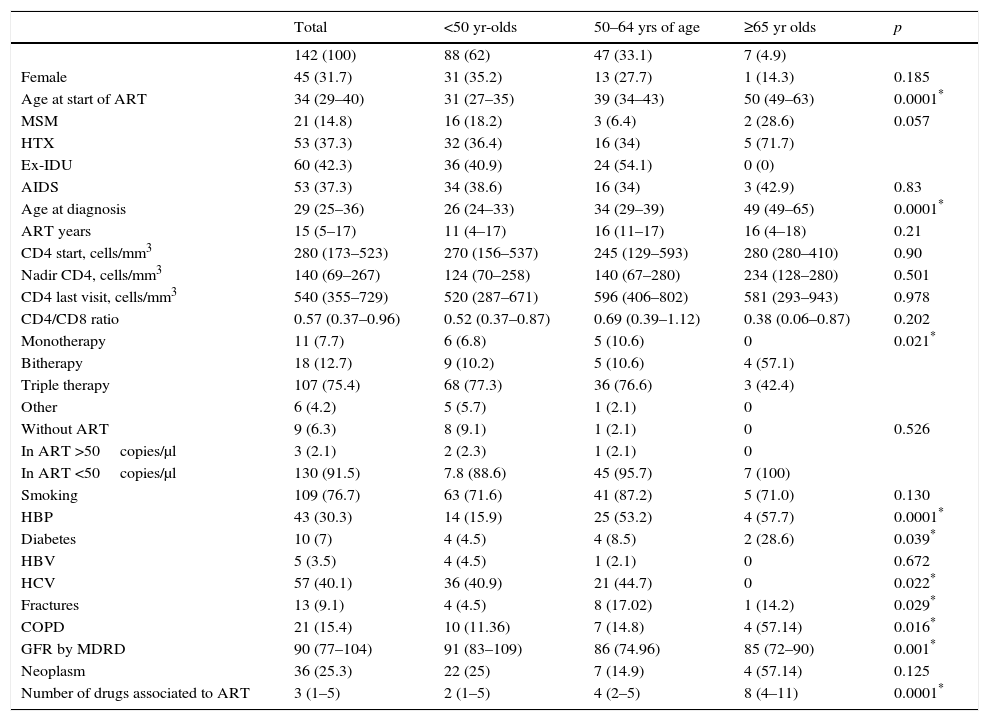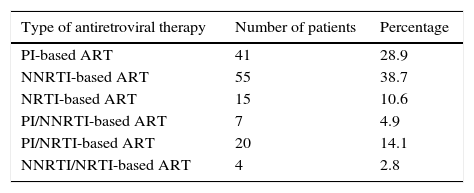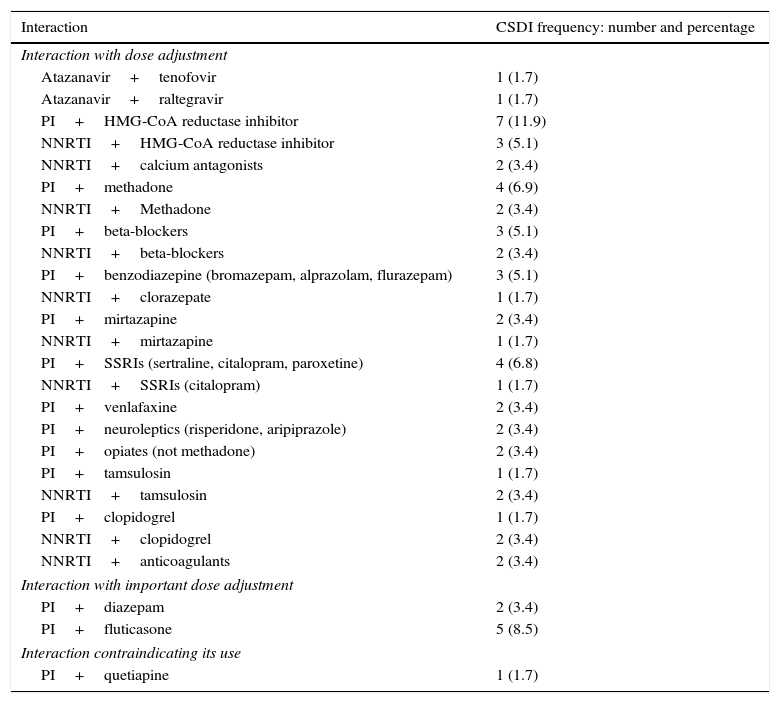To determine the prevalence and types of clinically significant drug–drug interactions (CSDI) in the drug regimens of HIV-infected patients receiving antiretroviral treatment.
Material and methodsDesign: retrospective review of database. Centre: Hospital Universitario Severo Ochoa, Infectious Unit. Participants: one hundred and forty-two participants followed by one of the authors were selected from January 1985 to December 2014. Data collection: from their outpatient medical records we reviewed information from the last available visit of the participants, in relation to HIV infection, comorbidities, demographics and the drugs that they were receiving; both antiretroviral drugs and drugs not related to HIV infection. We defined CSDI from the information sheet and/or database on antiretroviral drug interactions of the University of Liverpool (http://www.hiv-druginteractions.org) and we developed a diagnostic tool to predict the possibility of CSDI. By multivariate logistic regression analysis and by estimating the diagnostic performance curve obtained, we identified a quick tool to predict the existence of drug interactions.
ResultsOf 142 patients, 39 (29.11%) had some type of CSDI and in 11.2% 2 or more interactions were detected. In only one patient the combination of drugs was contraindicated (this patient was receiving darunavir/r and quetiapine). In multivariate analyses, predictors of CSDI were regimen type (PI or NNRTI) and the use of 3 or more non-antiretroviral drugs (AUC 0.886, 95% CI 0.828–0.944; P=.0001). The risk was 18.55 times in those receiving NNRTI and 27.95 times in those receiving IP compared to those taking raltegravir.
ConclusionsDrug interactions, including those defined as clinically significant, are common in HIV-infected patients treated with antiretroviral drugs, and the risk is greater in IP-based regimens. Raltegravir-based prescribing, especially in patients who receive at least 3 non-HIV drugs could avoid interactions.
Determinar la prevalencia y los tipos de interacciones farmacológicas clínicamente significativas (IFCS) en los regímenes farmacológicos de los pacientes infectados por VIH que están recibiendo un tratamiento antirretroviral, y desarrollar una herramienta diagnóstica que pueda predecir la posibilidad de una IFCS.
Material y métodosDiseño: revisión retrospectiva de bases de datos. Centro: Hospital Universitario Severo Ochoa, Unidad de Infecciosas. Participantes: 142 participantes seguidos por uno de los autores fueron seleccionados desde enero de 1985 hasta diciembre de 2014. Recogida de datos: recogimos en la última visita disponible de los participantes información relacionada con la infección VIH, las comorbilidades, los datos demográficos y los fármacos que estuvieran recibiendo, tanto los antirretrovirales como aquellos no relacionados con la infección VIH. Se definió la existencia de IFCS por la información de la ficha técnica y/o la base de datos de interacciones de fármacos antirretrovirales de la Universidad de Liverpool (http://www.hiv-druginteractions.org). Mediante el modelo de análisis multivariable de regresión logística y con la estimación de la curva de rendimiento diagnóstico obtenida identificamos una herramienta que nos pudiera predecir la existencia de interacciones farmacológicas.
ResultadosDe 142 pacientes, 39 (29,11%) tenían algún tipo de IFCS y en 11,2% se detectaron 2 o mas interacciones. Solo en un paciente la combinación de los fármacos estaba contraindicada (este paciente estaba recibiendo darunavir/r y quetiapina). En el análisis multivariable, los factores predictores de IFCS fueron el que estuvieran recibiendo un régimen basado en IP o ITINAN y la presencia de 3 o más fármacos no antirretrovirales (AUC 0,886, IC 95% 0,828-0,944; p=0,0001). El riesgo fue 18,55 veces en aquellos que recibían ITINAN y 27,95 veces en los que recibían IP con respecto a aquellos que tomaban raltegravir.
ConclusionesLas interacciones farmacológicas, incluyendo aquellas definidas como clínicamente significativas, son frecuentes en pacientes infectados por VIH tratados con antirretrovirales, y este riesgo es mayor en los regímenes basados en IP. Prescribiendo regímenes basados en raltegravir, especialmente en pacientes que reciben al menos 3 fármacos no relacionados con el VIH, se podrían evitar interacciones.













